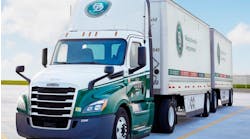Driver recruitment is an expensive but necessary part of owning or managing a fleet. Strategies can be implemented to improve the process, such as adding more details to the job posting that explain what kind of work a driver can expect, how long they'll be away from home, or how often they'll encounter tight driving situations, such as in an urban setting. Other strategies include making company values known during the early stages of recruitment. Not every great driver is a fit for every company, and explaining company values will help drivers understand if the company will be a good fit for them.
See also: Clark: The 'Great Resignation' is over, but fleets still have problems filling positions
But once a driver has been recruited, that's only half the equation. After drivers are onboarded and officially members of the team, a fleet leader’s next challenge is keeping them. While an American Transportation Research Institute study found the driver shortage to be the fourth top industry concern in 2023, driver recruitment was the eighth.
Invest in career growth
CarriersEdge, a provider of online driver training for the trucking industry, facilitates an annual rewards program called the Best Fleets to Drive For. Company drivers or owner-operators working with the fleets must nominate these companies for them to be considered. CarriersEdge conducts surveys from nominated fleets to determine the winners. Mark Murrell, CarriersEdge president and co-founder, told FleetOwner that these surveys reveal that "companies that invest in their employees tend to have happier employees who don't leave or are less likely to leave.”
See also: Same-gender training in the trucking industry
Investing in employees to increase retention could include investing in driver training and driver coaching. This will also help break up some of the monotony in a professional driving job, according to Murrell.
“Companies that invest in having substantial education programs for their drivers, they always have better retention, they have better performance,” Murrell said.
Additionally, fleet leaders can use driver training practices to turn their best drivers into driving coaches. This shows drivers there are growth opportunities within the company.
John Luciani, COO of A. Duie Pyle, a transportation and logistics services company (and No. 79 on the FO 500: For-Hire), said his company provides a “career path” for its drivers. During orientation, drivers meet some of the managers who were promoted out of a truck.
Luciani said this practice effectively demonstrates to employees “that we are committed to their long-term growth and achieving their career goals.”
Have a culture drivers want to work for
Jasper Purvis, VP of business development at Selerix, a benefits administration platform, pointed out that during the hiring process, staff members provide endless communication and a heightened level of engagement with a driver. But once the driver becomes a successful team member, that level of engagement tapers off drastically.
“We put so much effort into trying to find people,” Purvis said, “but how much effort do we really provide in keeping them?”
Purvis used the example of open enrollment with health care benefits. When enrollment time comes around, for employees that have or will soon experience a life-changing event, “those are the points in your life where those benefits are most important, and we don't do a very good job at talking to (the employee) when the employee needs it.”
This is where developing an open line of communication will greatly benefit both drivers and managers. Purvis suggested having an internal communication dashboard, such as a private Facebook group or a Slack channel. Still, Luciani said his drivers seem to appreciate a simple open-door policy and regular company newsletters.
Luciani said Pyle also facilitates an annual, anonymous company-wide survey to allow Pyle leaders to make improvements and give drivers a “vehicle” to provide constructive feedback “so their voices can be heard.”
Involvement is closely tied to engagement; for that, incentivization goes a long way. Purvis said friendly competition gets people involved and helps build and maintain a positive company culture. For example, fleets can use incentives to have departments, terminals, or regions compete for the most efficient or safest performance scores. This sense of competition also helps managers communicate consistently with their drivers. Incentivize managers to continue that engagement by getting their driving teams fully involved in the competition.
See also: A collision-reducing alternative to driver scorecards
Build up your greatest competitive advantage
Murrell’s advice to fleets when it comes to recruitment are to measure the results, not the actions taken. Instead of measuring how many calls a recruiter made or how many days it took to hire a new driver, Murrell said fleets should focus on how long new hires stick around, which drivers have the most longevity, and which hires don’t work out.
“Start at the end point of the successful hire, and then move forward in the process until you get to the recruiting stage,” Murrell told FleetOwner.
With retention, he advised looking “across the organization at where the issues are and including drivers in the solution.”
In line with involving drivers in solutions, Luciani stressed the need to build trust with each driver and staff member.
“It's the trust of ownership and senior leadership where we earn the discretionary effort of our employees to do the right things to satisfy the needs of our customers or to exceed the expectations of our customers,” Luciani said.
Though companies hire employees, what fills the open position is an individual. Luciani recognizes that A. Duie Pyle’s employees are the company’s “greatest competitive advantage," and have been throughout the company’s 100-year history.




